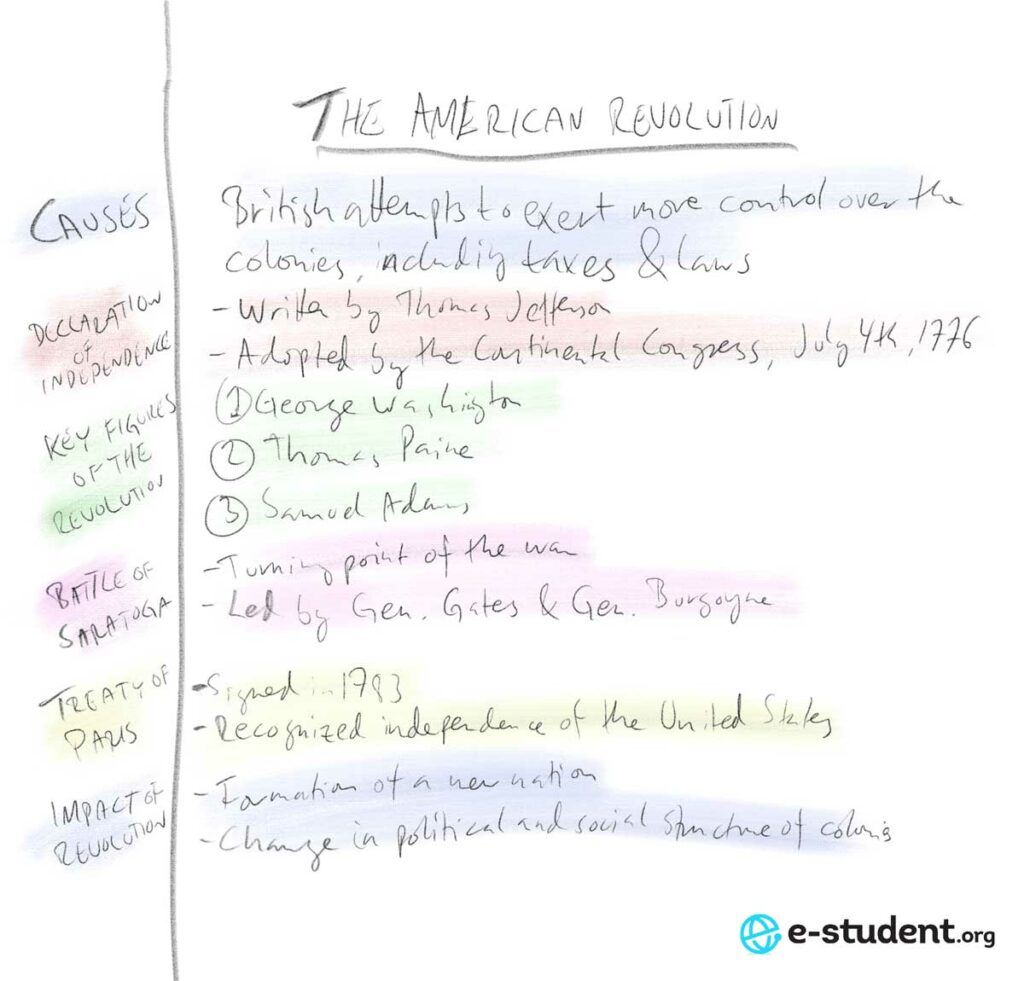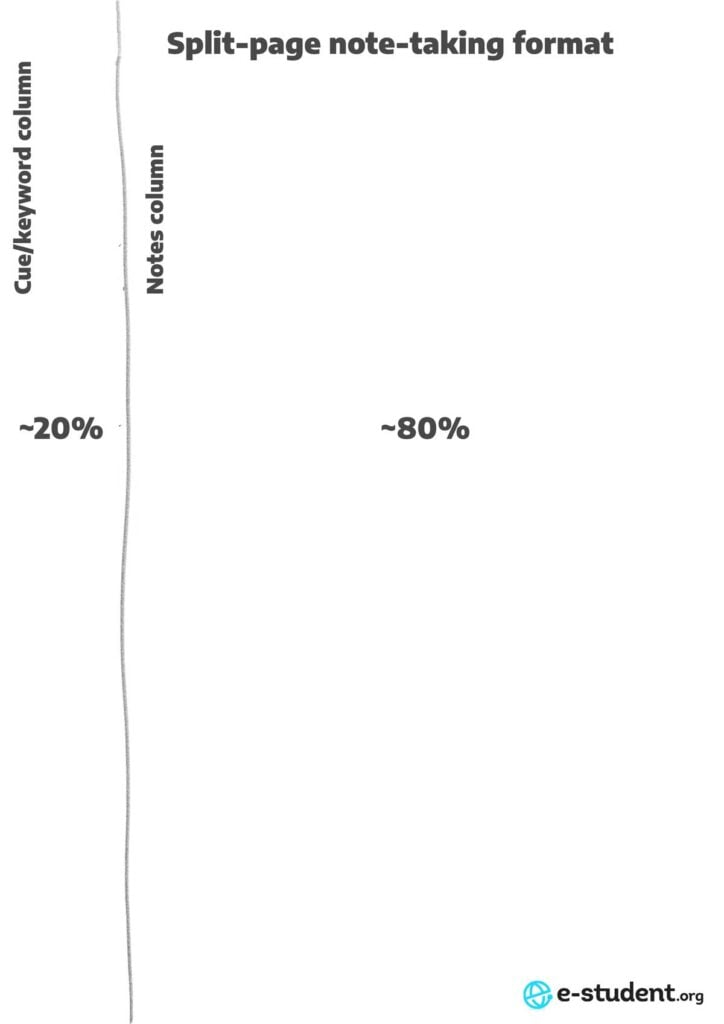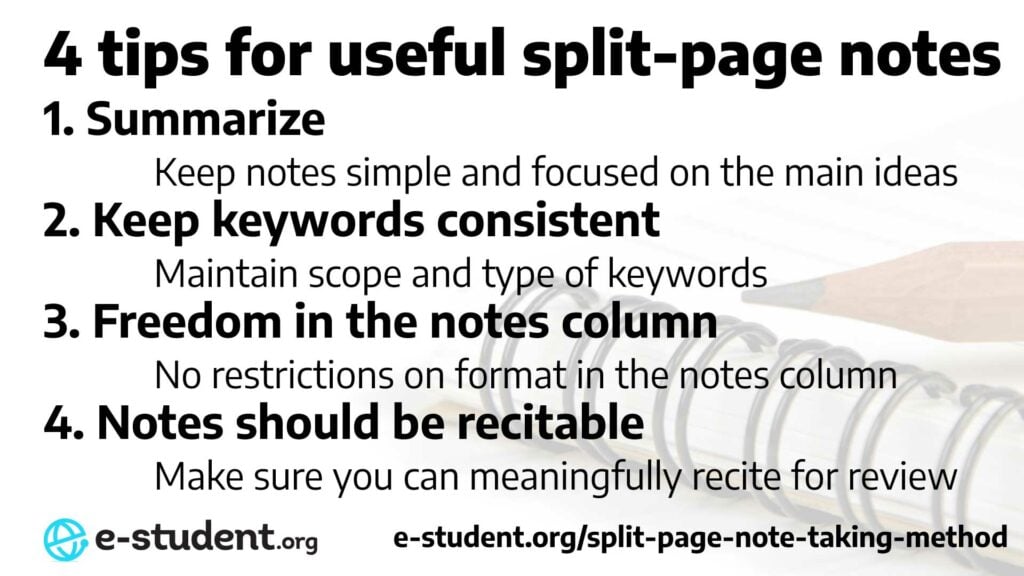- The split-page note-taking method is a simple but very useful approach to taking notes that can help you summarize complex information.
- Revising for exams is greatly facilitated by split-page notes, as you have a tool ready to go for active recall.
- Consider using a different method for information that’s multidimensional or with complex relationships.
Note-taking is an essential part of studying – it helps focus your attention and active listening, aids comprehension and retention, and improves critical thinking. But different note-taking methods are designed for different types of information and learning styles – and choosing the correct note-taking method will help you save time and effort and make sure you have the most useful notes possible. In this article, we will be looking at the split-page method of note-taking – a flexible approach to organizing your notes that lets you summarize and organize your notes in a way that provides you with a useful tool for revising and studying for exams.
Table of Contents
What is the split-page method of note-taking?
The split-page (also known as “two-column”) note-taking method, at its most simple, is a very straightforward approach: using a line to split the page vertically, you write your notes on the right side and keywords (or cues) on the left that categorizes or summarizes the notes. Alternatively, it involves writing the keywords on the left first and using the notes section to expand that with further information. While it is a very flexible method – you can enter your notes in any format that you find useful given the information at hand – the basic principle of dividing up the page in this manner constitutes a powerful approach to note-taking.

For what types of subjects is the split-page method suitable?
The split-page method is particularly useful for subjects that present you with a lot of detailed information that you need to summarize. This is true for many subjects in the humanities, but thanks to its flexibility, the method can also be useful in most other subjects, even if there is less summarizing needed. This is particularly the case if letting yourself use different kinds of notes in the right column – you could put diagrams, lists, mapping charts, etc., in the right column, rather than only summary text.
While it is a flexible method, keep in mind that another note-taking method might be more suitable for a given topic. This is especially true for information more complex relationships, as these relationships can be hard to visualize with only the relationship between cue and note columns at your disposal.
Advantages and disadvantages of the split-page method
While the split-page method is one of the overall most useful methods for note-taking, it comes with both advantages and disadvantages.
These are the primary advantages of the split-page method:
- The two-column structure provides a useful revision tool for using active recall to study for exams, interviews, etc.
- It is straightforward enough to use directly during class
- It is easy to review notes after class and add keywords as needed
- One of the most widely applicable note-taking methods.
On the other hand, these are the main disadvantages of the split-page method:
- Focus on summarizing can make it less suitable for fast-paced lectures or lectures that jump between topics (consider using the sentence method or outline method)
- It is less suitable for information with more complex relationships (consider the mapping method or QEC method) or with multiple dimensions (consider using the charting method)
How to take notes with the split-page method
To take and use notes with the split-page method, follow these steps:
Preparations
The split-page method is best done on paper with a pen or pencil (ideally a quality pencil), as it gives you the freedom to format your notes in the right column as you prefer (and is overall better for learning).
Take out a good ruler and draw a vertical line so that the left column takes up about 20% of the page, and the right column 80%. For A4 or letter-size paper, that means about 1.5 inches (approximately 4 cm) from the left margin. If you find that you need more space for your keyword/cue column, adjust as needed.

You can, however, also use a computer for split-page notes. My recommendation is to write your notes in a two-column table. You can do this either in a word processor or in a spreadsheet.
Preformat the table so that the column width is approximately 20% for column one and 70% for column two. This way, by making sure you use a new column row when you move to a new keyword/cue, you can ensure that your notes are aligned. If using a word processor, don’t format the document directly to have columns, or you will struggle to keep the keywords and notes lined up. Instead, insert a table into the document. Alternatively, if you have specialized note-taking software that can handle split-page notes, then you can, of course, use that.
Add the first keyword
Start with adding the keyword in the left column for the first point raised during the class.
In our example, we are following a sociology class on “Social Stratification.” The first keyword we enter is “Definition.”
| Social Stratification | |
| Definition |
Write your notes
Based on what is presented in the class, fill in the notes column to provide the detail for the keyword. Unless the lecturer is very brief and to the point, do not transcribe exactly what he’s saying – try to summarize to the extent possible.
In our example, we’ll add “The division of society into different social classes based on wealth, power, and prestige” in the right column next to our keyword.
| Social Stratification | |
| Definition | The division of society into different social classes based on wealth, power, and prestige |
Repeat for each main point
For each new point that is raised in class, add a new keyword and notes. Try to keep the keywords of a somewhat similar scope so that the notes can be more easily used for revision.
We’ve completed the notes for the class on social stratification below – and we’ve also put together a few additional examples at the end of this article.
| Social Stratification | |
| Definition | The division of society into different social classes based on wealth, power, and prestige |
| Types |
|
| Concept of class | Based on economic position and access to resources |
| Concept of power | The ability to control resources and make decisions that affect others |
| Concept of prestige | The social respect and honor accorded to different groups in society |
| Impact on society | Inequalities in access to resources, opportunities and power. |
Note that you will often want to reverse the steps and write the notes first and add the keywords/cues afterward. This is normally the case if you are following a lecture that is less clearly structured, making it difficult to tell what the appropriate keyword would be before writing your notes. You would then write all your notes, maybe adding a keyword here and there where obvious, but then leave it to your review afterward to add the rest of the keywords.
Studying with your split-page notes
Like all note-taking, the most important thing is to actually use your notes when revising. However, with the split-page method, you will have a perfectly formatted revision resource from the outset.
When revising, cover over the notes. Go through the keywords/cues one by one and try to recite the main points from memory. If possible, speak out loud and try to speak with confidence. This can be helpful even if you are preparing for a written exam.
Tips for useful split-page notes
Advice for how to effectively use the split-page method is along the same lines as for effective note-taking in general. But think in particular of the following:
- Summarize: Keep your notes simple and focused on the main ideas and concepts. Don’t copy everything that is being said.
- Keep keywords consistent: When possible, keep the basic format of your note pages the same, with keywords of similar scope and type on the left to make the review more straightforward.
- Freedom in the notes column: Don’t feel restricted to using a specific format for the notes column – instead, use the format that suits the information the best, whether sentences, lists, tables, etc.
- Notes should be recitable: Regardless of the format in the notes column, make sure that you write the notes in a way that you can meaningfully try to recite them when reviewing (covering the notes column and only showing the cue words)

How does the split-page method relate to other note-taking methods?
As with all note-taking methods, it’s worthwhile to consider how they relate to other note-taking methods, so you are better prepared to select the most suitable one for any given situation.
For the split-page method, the most common confusion is with the Cornell method. Some claim that the split-page method is the same as the Cornell method. This is, however, not correct. The Cornell method can best be described as a sub-method to the split-page method, which is a more generic approach to note-taking. The main differences are the following:
- The Cornell method follows a very specific format (you can even buy Cornell note-taking paper), whereas, with the split-page method, it is up to you to decide where to draw the line (pun intended)
- The Cornell method adds a Summary section at the bottom of each page. This leads to a different format, with three sections instead of two with the split-page method. But it also leads to a quite different approach to note-taking, where each page should be more self-contained so you can write a meaningful summary, rather than the split-page method where you can keep going for a topic on any number of pages without running into any formatting concerns.
- The Cornell method also establishes specific labels for its sections (Cue, Notes, and Summary – but they are often left unlabeled in practice), while in the split-page method, you can call your cue and notes columns what you like!
The split-page method can also be seen as an improved version of the sentence method of note-taking. While the sentence method summarizes the information in full text, you could see the split-page method as adding cues to this text to make it easier to read and review. However, with the split-page method, you would often combine full sentences with other types of notes, such as drawings and lists, in the notes column.
The charting method of note-taking (or the “matrix method”) is fairly closely related to the split-page method. The split-page method can be seen as a chart with just two columns and each cue and note-pair being a row. However, as the charting method can accommodate a matrix of multiple columns and rows, it is more suited for structured information that should be compared by several properties (for example, comparing several cities by population, local tax rate, gross tax receipts, and high school enrolment rate). While the split-page method of note-taking does not have the advantage of an easy overview of multiple properties, it comes with much greater flexibility for how you structure your notes.
Additional example notes using the split-page method
To help you get a better idea of what split-page notes can look like, we’ve also included a few additional examples from different subjects below.
History
| The French Revolution | |
| Causes of the Revolution |
|
| Fall of the monarchy | Execution of King Louis XVI in 1793 |
| The Reign of Terror | Period of violence and mass executions led by Robespierre |
| Rise of Napoleon | Napoleon Bonaparte took control of government in 1799, eventually becoming Emperor |
| End of the Revolution |
|
| Impact of the Revolution |
|
Philosophy
| Philosophy of the Mind | |
| Definition | The study of the nature of the mind, mental states, and mental processes |
| Dualism | The belief that mind and body are separate entities |
| Materialism | The belief that mind and body are the same |
| Functionalism | The belief that mental states can be explained by their functions |
| Eliminative Materialism | The belief that certain common-sense mental states do not exist |
| Impact of Philosophy of the Mind on society | The impact of different theories on the understanding of
|
Conflict Studies
| Causes of War | |
| Theories of war causes |
|
| Realism | War is caused by the inherent human nature and states’ quest for power and security |
| Liberalism | War is caused by lack of communication and cooperation among states |
| Constructivism | War is caused by the changing norms and ideas of the society |
| Role of economic factors |
|
| Role of domestic factors | Political and social factors that influence the decision to go to war |
| Role of external factors | The influence of other states and international organizations |



